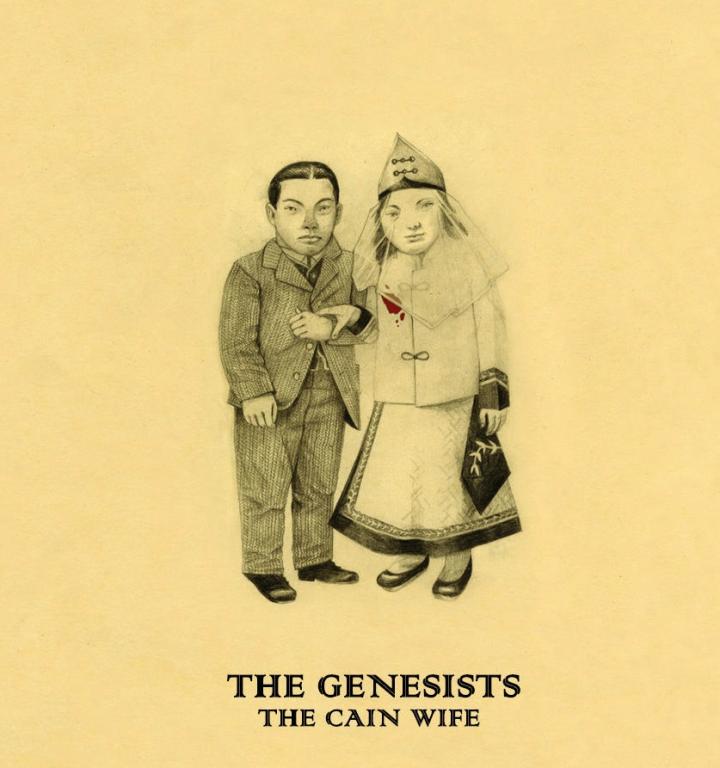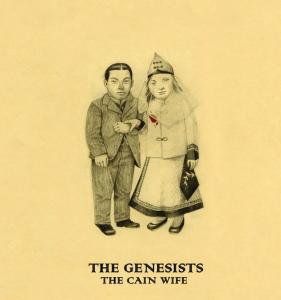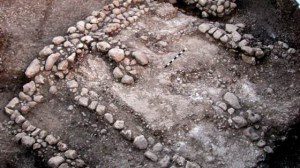“Wait, who did Cain marry?”
If you grew up in church, then at some point you asked that question.
 Maybe you were a devout, earnest young person. You were on fire for God and you were praying that God would just, Lord, just draw you closer to Him, Lord, and just, Lord, just show you His will for your life. You were all in, and when your youth minister challenged you to read through the entire Bible in a year you set out to do it.
Maybe you were a devout, earnest young person. You were on fire for God and you were praying that God would just, Lord, just draw you closer to Him, Lord, and just, Lord, just show you His will for your life. You were all in, and when your youth minister challenged you to read through the entire Bible in a year you set out to do it.
Or maybe you were a smart-aleck lobbing spitballs and commentary from the back row in Sunday school.
Or maybe you were just an anxious kid, reflexively second-guessing your teachers the same way you constantly second-guessed yourself.
Or maybe all of those at the same time.
But at some point you ran into this passage and realized you just couldn’t make it fit with what you’d been taught about everything that came before it.
Unless you’re some kind of liberal who rejects what gets called a “literal reading” of Genesis, then at the beginning of Genesis 4, the Earth has a human population of four. And by verse 9, that’s down to three: the literal historic individual Adam, his literal historic wife Eve, and their literal historic son Cain, who just murdered their other literal historic son Abel.
And then we read this:
Genesis 4:10-17
And the Lord said, “What have you done? Listen; your brother’s blood is crying out to me from the ground! And now you are cursed from the ground, which has opened its mouth to receive your brother’s blood from your hand. When you till the ground, it will no longer yield to you its strength; you will be a fugitive and a wanderer on the earth.” Cain said to the Lord, “My punishment is greater than I can bear! Today you have driven me away from the soil, and I shall be hidden from your face; I shall be a fugitive and a wanderer on the earth, and anyone who meets me may kill me.” Then the Lord said to him, “Not so! Whoever kills Cain will suffer a sevenfold vengeance.” And the Lord put a mark on Cain, so that no one who came upon him would kill him. Then Cain went away from the presence of the Lord, and settled in the land of Nod, east of Eden.
Cain knew his wife, and she conceived and bore Enoch; and he built a city, and named it Enoch after his son Enoch.
The nuclear family that makes up the only humans this story will “literally” allow is suddenly surrounded by a host of strangers, foreigners, Nod-ites, potential spouses and a previously unmentioned cast of thousands.
What’s up with that? Where did all these people come from? Where did Cain find this wife of his?
It’s possible, but unlikely, that you asked that question as a young person in church and that you were given a responsible answer. Maybe someone discussed the difference between this kind of theological origin story in Genesis and the kind of story meant to convey the actual events of history. Maybe they discussed how these origin stories were originally stories for Israel.
But probably not. What you were probably told,rather, was an odd babble of legends, half-remembered allusions to other legends, and improvised-on-the-spot ideas that your Sunday school teacher was just as surprised as you to hear coming out of his mouth. You were probably given an “explanation” that involved Cain marrying some previously unmentioned sister — followed by some reassurance that this would have been perfectly fine due to some mumbled rehash of a pulpit myth mangling both genetics and Mosaic law. And all the foreigners and strangers Cain was afraid of — “anyone who meets me may kill me” — were all just more of Cain’s otherwise unmentioned and unnamed brothers and sisters.
In other words, your question, “Wait, who did Cain marry?” didn’t really receive an answer so much as a string of words that threatened to continue flowing until you yielded and agreed not to press the point any further.
It would be helpful to have some studious, enterprising new Brunvand to compile and study all of these pulpit myths and this ever-mutating body of Sunday-school folklore. But until then, the next best thing is Answers in Genesis — which collects, refines and repackages much of this folklore, presenting it as truth.
The Answers in Genesis discussion of Cain’s wife — written by AiG founder Ken Ham himself — is deliriously goofy.
You can skip over most of Ham’s initial tribalist throat-clearing, which stakes out out the us-vs.-them stakes of not memorizing the correct, AiG-approved response. “Skeptics of the Bible have used Cain’s wife time and again to try to discredit the book of Genesis as a true historical record,” Ham says, going on for another 700 words or so about how important it is to not allow such anti-Bible “skeptics” to think they’re winning.
But then things get really weird. Cain’s wife must be his sister, Ham argues, because otherwise it’d be like saying Adam wasn’t the very first unique human. And that’s terribly important because, according to Ham, “The Bible makes it clear that only the descendants of Adam can be saved.”
Thus, if Christians cannot defend that all humans, including Cain’s wife, can trace their ancestry ultimately to Adam and Eve, then how can they understand and explain the gospel? … Therefore, one needs to be able to explain Cain’s wife, to illustrate that Christians can defend the gospel and all that it teaches.
The language there is English. And I recognize all of the words there. But I still find those sentences baffling.
Ham proceeds to retcon the early chapters of Genesis, shuffling the chronology a bit and turning parts of Chapter 5 into a flashback preceding Chapter 4 — all in the name of a “literal” reading of the text. But throughout this fast-talking and dealing from the bottom of the text Ham seems to realize that the core problem he’s facing here is the disturbingly Flowers-in-the-Attic scenario necessitated by insisting on a single original family of original humans.
“One of the reasons many Christians cannot answer the question about Cain’s wife is that they tend to look at today’s world and the problems that would be associated with close relations marrying,” he writes, saying that this involves “taking a secular way of thinking to the Bible.” Christians must set aside their secular incest taboos in order to understand “the simple answers” of Genesis genetics:
If we now work totally from Scripture, without any personal prejudices or other extrabiblical ideas, then back at the beginning, when there was only the first generation, brothers would have had to marry sisters or there wouldn’t have been any more generations!
… When the first two people were created, they were perfect. Everything God made was “very good.” That means their genes were perfect — no mistakes. But when sin entered the world because of Adam, God cursed the world so that the perfect creation then began to degenerate, that is, suffer death and decay. Over a long period of time, this degeneration would have resulted in all sorts of mistakes occurring in the genetic material of living things.
But Cain was in the first generation of children ever born. He, as well as his brothers and sisters, would have received virtually no imperfect genes from Adam or Eve, since the effects of sin and the Curse would have been minimal to start with. In that situation, brother and sister could have married (provided it was one man for one woman, which is what marriage is all about) without any potential to produce deformed offspring.
By the time of Moses (about 2,500 years later), degenerative mistakes would have accumulated to such an extent in the human race that it would have been necessary for God to bring in the laws forbidding brother-sister (and close relative) marriage.
(Gotta love that “one man for one woman” swipe in there. Ham says this in the midst of trying to defend Genesis 4:17. Here’s the beginning of Genesis 4:19: “Lamech took two wives …”)
Ham’s theme of gradual, inexorable human degeneration is something he stresses throughout his argument. “The human race is slowly degenerating as mistakes accumulate generation after generation,” he says. That’s part of the explanation, he says, for why so many people seem unable to grasp “the simple answers” he provides:
We must remember that our brains have suffered from 6,000 years of the Curse. We have greatly degenerated compared to people many generations ago.
And then Ham gets all Ancient-Astronaut-y — suggesting that Adam and his first children may have had superior technology to what we have today:
Adam and Eve’s descendants were very intelligent people. We are told that Jubal made musical instruments, such as the harp and organ, and Tubal-cain worked with brass and iron.
Because of intense evolutionary indoctrination, many people today have the idea that their generation is the most advanced that has ever been on this planet. Just because we have jet airplanes and computers doesn’t mean we are the most intelligent or advanced. This modern technology is really a result of the accumulation of knowledge.
… Scripture gives us a glimpse of what appears to be advanced technology almost from the beginning.
Cain had the knowledge and talent to know how to build a city!
That’s kind of disappointing. Ham can usually be counted on for coming up with goofily inventive attempts to patch the holes in his leaky construct, but this is just a bit of badly recycled Chariots-of-the-Gods nonsense minus the aliens. Where’s the originality?
Tubal-cain deserves better. Cain’s iron-working heir is too much of a howling anachronism for such a weak explanation. The book of Genesis, Ken Ham insists, was dictated by God and written down by Moses “about 1445–1405 BC” — centuries before anyone had imagined the “iron tools” Tubal-cain is credited with inventing in Genesis 4:22. That verse might as well speak of Tubal-cain’s sonic screwdriver or his fusion-powered DeLorean and Calvin Klein underwear.
If Ham couldn’t come up with anything better than his “advanced technology almost from the beginning” claim for this, then he should fully commit and run with it. If we’re going to take “all kinds of iron tools” to mean “advanced technology” then let’s give the children of Cain some advanced technology — ray guns, tricorders, smart phones, Zeppelins … the skies are the limit.















